Royal School for the Blind, Liverpool
The Royal School for the Blind in Liverpool, England, is the oldest specialist school of its kind in the UK, having been founded in 1791.[1] Only the Paris school is older, but the Royal School for the Blind is the oldest school in the world in continuous operation, and the first in the world founded by a blind person, Edward Rushton, who was also an anti-slavery campaigner.[2] It was also the first school in the world to offer education and training to blind adults as well as children.[3]
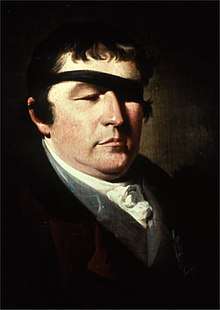
Early history
The first building to be used by the school was quite unsuitable. Situated at 6 Commutation Row, Liverpool, opposite the potteries of Shaw's Brow (now William Brown Street), two houses recently erected were rented by the charity for the sole use of the school. They were much too small and by 1800 enough money had been raised to erect a purpose built school nearby on the site later occupied by the Odeon cinema on London Road. Designed by John Foster junior (later Architect & Surveyor to Liverpool Corporation) the school was now well and truly established and would stay on this site for the next 50 years.[5]

In 1806 during a royal visit to Liverpool by the Prince of Wales (later George IV) and the Duke of Clarence (later William IV), the royal entourage visited the School for the Blind, where they met pupils and inspected some of the manufactured goods on show. After being entertained by the choir of the school singing the 'Halleluiah Chorus', the Prince ordered 10 guineas to be distributed among the pupils and bestowed 100 guineas on the school as well as his royal patronage which has continued unbroken to the present day.
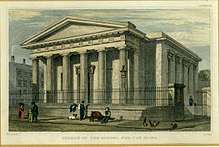
The gift was a great boost to the Institution which was raising funds to extend the site. Architect John Foster was again engaged, and land to the rear of the building was secured and building began on new facilities in 1807. Completed in 1812, 53 males and 18 females moved into the buildings which were now fully residential, with work rooms, technical facilities and music rooms. The mission of the school guardians was that the institution would be 'less of an asylum, where the ease a comfort of the blind were principally considered, and more approaching a school, where pupils could be instructed in some useful art or trade, by which they might be enabled to procure for themselves a comfortable livelihood.'
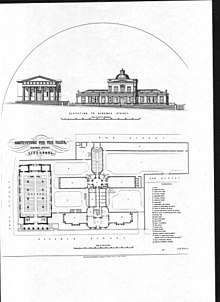
In 1819 a chapel was opened by the school on adjoining land, with a connecting tunnel for the pupils to avoid the road and traffic above. John Foster was asked to draw up plans and being fresh from a tour of Greece and the islands, the classical influence was captured in the Doric frontage to the building. This influence would be carried over into other local building during his career as the city architect.
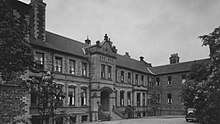
As Lime Street Station began to expand at the height of 'Railway Mania', pressure was being brought to bear on the owners of local properties and the school guardians began to make plans to move once more. The L.N.W.R. agreed in 1849 to exchange land they held in Hope Street and Hardman Street, plus the sum of £9,500 for the entire estate adjoining Lime Street Station owned by the school. A further £2,000 was given to the school for the chapel and its removal. This was to entail the transfer of the chapel to the new site on the corner block of Hope Street and Hardman Street where it was re-erected in its entirety, apart from its front steps, the local council refusing to grant the necessary space. The new school building, designed by Arthur Hill Holme, and erected alongside the chapel facing Hardman Street, opened in 1851, with eighty-five pupils.
With the passing of the Elementary Education (Blind and Deaf Children) Act in 1893, the Hardman Street School could not provide the required facilities laid down by the new legislation. Thanks to Mary Louisa Hornby, who was a major benefactor, Wavertree Hall was purchased in Church Road, Wavertree, the original hall demolished and the new school opened in November 1898. Taking in children from the age of five to sixteen, they would then be transferred to the Hardman Street School for technical training.[5]
Early 20th century

Due to dwindling attendances and the Chapel having no parish of its own, it was decided to close the building in 1930, with its demolition later that year. There was great debate over the fate of the Doric front which was saved, but nothing came of the numerous suggestions. A new extension was opened in 1932 on the same site, designed by the architects Anthony Minoprio and Hugh Spencely,[6] which provided additional work space, recreation rooms, offices and a sales shop for the goods manufactured by the students.
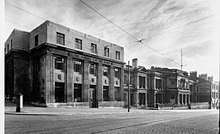
During the Second World War, both the Wavertree School and Hardman Street were evacuated with staff to Rhyl, moving together on 1–2 September 1939. Four buildings were taken over; the former North Wales School for Blind Children in Russell Road; Clwyd Lodge next door; Northgate House and Penrhyn Lodge, staying there for the duration, returning to Liverpool in 1946. Part of the Hardman Street school had been requisitioned by the R.A.F. until then.
Post war and the 1944 Education Act
Following the changes introduced by the new Act, Wavertree became a school for mixed pupils aged 7–11, with Henshaw's School for the Blind in Manchester taking senior children. Those with academic promise were sent to Worcester College for Boys, Chorleywood College for Girls or the Royal Normal School, where pupils would generally stay until they were eighteen. The Hardman Street School became a technical college for the North West region for those aged sixteen to twenty-one. General academic education would continue, plus the provision of vocational training in basket making, shoe repairing, brush making, and hand, flat and round machine knitting - all wholly inadequate in a modernising post war industrialised world where many blind persons were now being taken on under the terms of the Disabled Persons Employment Act of 1944. The technical college failed to move with the times, consequently numbers dwindled leading to the closure of the establishment in 1957. The building was sold to Liverpool Corporation in 1959, who leased it to the City Police who used as their headquarters until they moved to Canning Place in 1982. It was then used as the Merseyside Trade Union Community and Unemployed Resource Centre' with facilities including conference and function rooms, a small theatre, lounge, bar and a basement recording studio. It was also the used as the Flying Picket music venue. In 2015 it was refurbished and opened as the Old Blind School restaurant, but closed in June 2017. In April 2018 it reopened as The Florist restaurant [7]
The Wavertree School continued under the headship of Derek Marks from 1960, who, keen for the school to modernise, quickly introduced the Perkins Brailler. With only two machines in the country - both owned by the R.N.I.B., he placed an order for sixty with the bemused American manufacturers. Children were allowed to take them with them when they moved on to senior school. Additional buildings were added on site, together with a swimming pool in 1964 and the landscaping of the grounds, with its additional recreation areas. There was further expansion in 1966, when the Abbeyholme estate alongside the school was acquired, then in 1972 when Clifton House to the rear of the school facing Prince Alfred Road was purchased.
The school was moving into a successful phase under Derek Marks and his dedicated staff, who were keen to introduce new ideas and revolutionary techniques where possible. However, more change was on the way, and as the effects of the Warnock Report took hold in the late 1970s the role of the school began to change. Under the Education Act of 1976, and later the 1981 Act, provision was made for blind and partially sighted children to be educated in the mainstream, while Wavertree began to accept children with additional challenges. By 1983 the role of the school was extended to the 'education of physically handicapped children with severe learning difficulties, and other handicaps, between the ages of three and eighteen, who would not be catered for in their local schools.' The transition took time and was finally reached by August 1989.
In 1990, in tribute to over forty years of commitment and dedication in the caring and education of children with special needs, headmaster Derek Marks was awarded the O.B.E. The award was announced as he was celebrating thirty years as headmaster of Wavertree.
By coincidence, in the same honours list was Ronald Wright, a pupil at the school from 1935 to 1944, who was awarded the B.E.M. for his work in the Civil Service.
Also announced in 1990 was a new phase of development and a visit from the school's royal patron.
The bicentenary of the school and a visit by H.M. The Queen
In 1989, historian Mike Royden was asked by the school to look at the school archive with a view to producing a history of the school in time for the anniversary. The archive is extensive with volumes dating back to 1773, containing, for example, complete sets of Management Committee minute books and Annual Reports from 1793, Admissions Registers, medical reports, Visitors Reports, and Treasurers Reports. All were researched and indexed at this time. The subsequent history by Mike Royden, Pioneers and Perseverance - A History of the Royal School for the Blind 1791-1991 was published in 1991. A diary kept by the pupils during their evacuation to Rhyl was also discovered and included in the appendix.
The Bicentennial appeal fund was launched on 13 November 1990 with a target of £2.5 Million, to provide new facilities for the challenges ahead, which included new classrooms, a hydrotherapy pool and residential facilities for parents.
During the research for the school's history, Mike Royden discovered the fate of the Doric front of the Chapel demolished in 1930. Six columns in triple sections, their capitals and plynths, were found lying in the undergrowth at Camphill in Woolton, where they had lain undisturbed for sixty years. Part of the new development at the school was a water garden for the pupils, and it was decided to bring back one of the column sections, plus its capital, and have it redesigned as a centrepiece water fountain. This was unveiled by the Queen on her tour of the school in 1991. The Queen met pupils and staff and toured the school facilities, and also inspected part of the school archive. On her departure, the headmaster presented the Queen with a leather bound copy of the new history of the school.
21st century
In 2004, former pupil Steve Binns was awarded an MBE for contributions to heritage, which was received from HRH Prince Charles at Buckingham Palace. In 2007, this was followed by the award of an Honorary Fellowship of Liverpool John Moores University.
In 2010, the school's headmaster, Joseph Byrne, was appointed OBE.[8]
In 2011, the school was cited as one of the reasons (along with local blind charity Bradbury Fields) for UK supermarket Sainsbury's choice to use a store in nearby Woolton for its trial of Braille signage.[9]
The Redwall series of books was first written for pupils at the school[10] when its author Brian Jacques worked there as a delivery driver.[11] From 2016, the History of Place project carried out archival research at the school,[12] uncovering and making public documents including diaries of some of those who attended the school,[13] uncovering architectural heritage of the school, which moved several times in Liverpool.[14] The Museum of Liverpool is holding an exhibition featuring the history of the school in 2018.[15]
Today, the Royal School for the Blind provides places for up to 66 pupils ranging in age from 2–19 years and beyond. All students have a Visual Impairment and Multiple Disabilities including difficulties ranging from moderate to profound. The children are taught in small groups with a high staff ratio. All pupils have access to the (EYFS) National Curriculum and a discrete 16-19 curriculum with an increased emphasis upon Independent Skills and Vocational Skills.
Historical abuse allegations
In January 2017, various media outlets reported allegations of historical physical abuse against a deceased former headmistress, Margaret McLenan, who was in post in the 1950s.[16] In response, Susan George, president of the school, was reported to be saddened by the allegations.[16]
Further reading
Royden, Michael W., Pioneers and Perseverance - A History of the Royal School for the Blind, Liverpool 1791-1991 (1991) Countyvise.
Royden, Mike, Edward Rushton - Oxford Dictionary of National Biography (2001) O.U.P.
Hunter, Bill, Forgotten Hero: The Life and Times of Edward Rushton (2002)
Thomas, Mary G., Edward Rushton – N.I.B. Biographies No.1 (1949)
Shepherd, W. (Memoir of Edward Rushton: )Poems and other writings - with a sketch of a life of the Author’ (1824).
External links
Royden, Mike, Edward Rushton - life and times of an 18th Century Radical and the foundation of the Blind School in Liverpool, Mike Royden's Local History Pages
Iain Mitchell, Memories of the Royal School for the Blind, Liverpool in the 1970s
Former Pupils
David Francis (1865-1929) - Welsh harpist
Steve Binns M.B.E. - Liverpool Historian and tour guide
References
- Royden, Mike. "Edward Rushton - life and times of an 18th Century Radical and the foundation of the Blind School in Liverpool". Mike Royden's Local History Pages.
- Royden Mike, Edward Rushton, Oxford Dictionary of National Biography (2001). Unsung: life story of Edward Rushton. http://historyof.place/unsung-remembering-edward-rushton/
- The Blind in British Society: Charity, State and Community c1780-1930 Gordon Phillips, 2004 Ashgate Publishing Ltd.
- out of copyright
- Royden, Mike (1991). Pioneers and Perseverance - A History of the Royal School for the Blind, Liverpool (1791-1991. Liverpool: Countyvise. ISBN 0907768393.
- "The Blind School Extension". Friends of Liverpool Monuments. Retrieved 1 April 2014.
- Lottie, Gibbons. "First look inside The Florist at the former Old Blind School". Liverpool Echo. Retrieved 2019-07-16.
- "Rugby commentator Ray French appointed MBE". BBC News.
- "Sainsburys in Woolton is first in UK to have braille signage for blind customers". Liverpool Echo. Retrieved 2011-02-04.
- "Redwall author Brian Jacques dies aged 71". BBC News.
- "About". Redwall.org.
- Liverpool School for the Indigent Blind Timeline http://historyof.place/location/liverpool-school-for-the-indigent-blind/
- Our evacuation diary http://historyof.place/our-evacuation-diary-1939/
- History of place - maps and the Liverpool school for the indigent blind http://historyof.place/historic-images-of-the-school-for-the-blind/
- Museum of Liverpool exhibition about the School for the Blind. http://historyof.place/events/exhibition-at-the-museum-of-liverpool/
- West, Kate (9 January 2017). "Liverpool Royal School for the Blind headmistress 'abused children'". BBC Radio Manchester. Retrieved 9 January 2017.
thumb